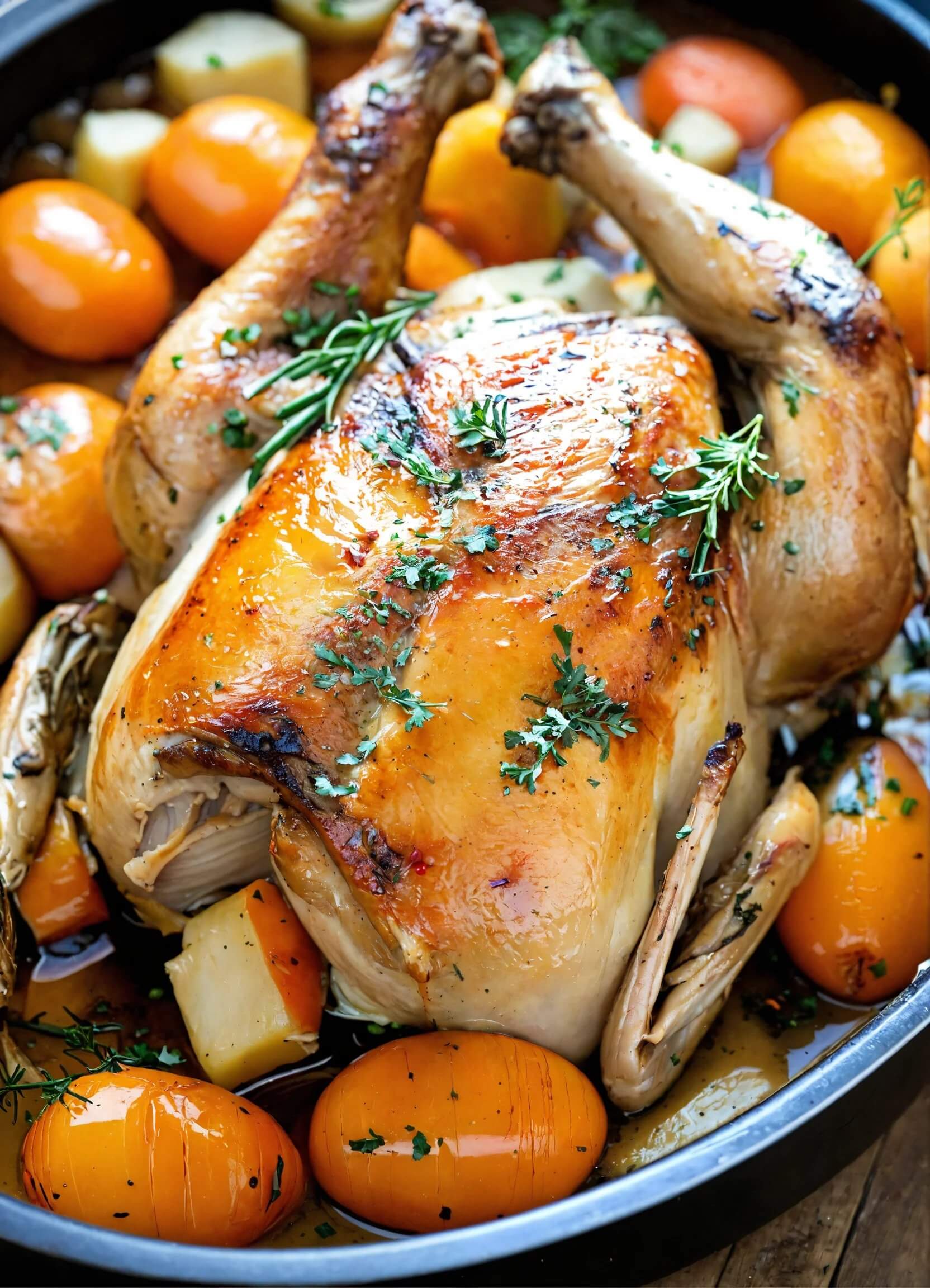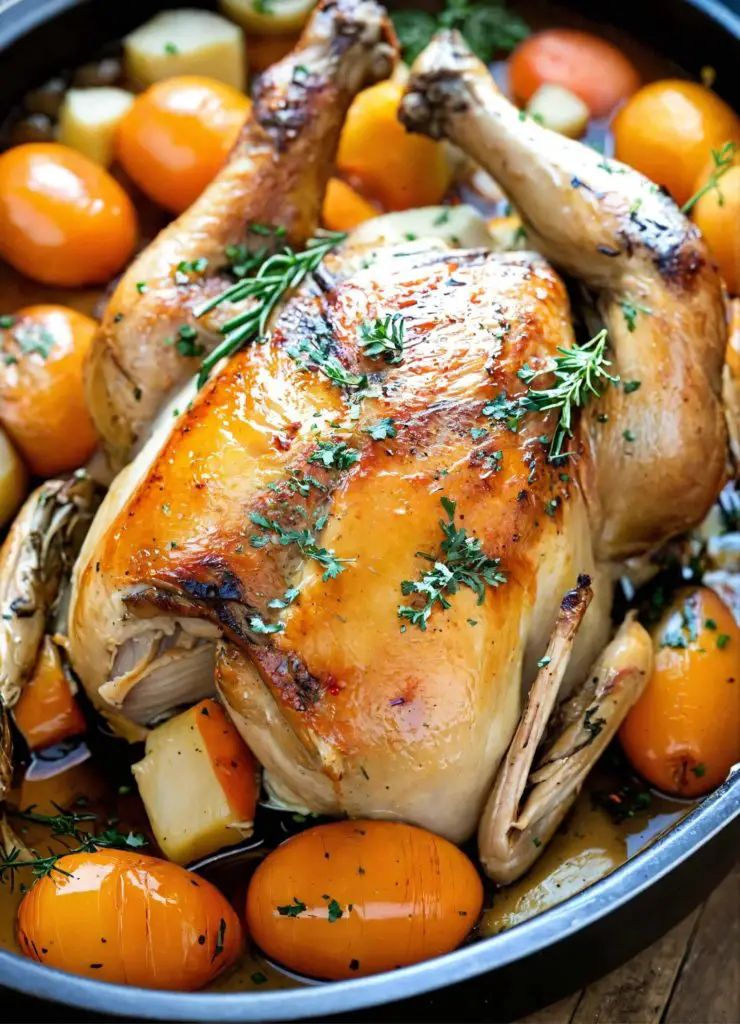Introduction to Pot Roast Chicken
Pot roast chicken, a dish steeped in culinary tradition, has been a centerpiece on dining tables for centuries. Its origins, while not precisely documented, are deeply rooted in the concept of slow cooking, a method embraced by various cultures around the world. This technique, which involves cooking the chicken at a low temperature over a long period, allows the flavors to develop and permeate the meat, resulting in a tender and succulent dish.
The popularity of pot roast chicken spans continents, with each region adding its unique twist to the recipe. Whether it’s the classic French poulet en cocotte, where the chicken is cooked with wine and herbs, or the American version, often accompanied by root vegetables and rich gravy, the essence of pot roast chicken remains the same – a hearty, comforting meal that brings people together.
The cooking methods for pot roast chicken vary, ranging from using traditional ovens to modern slow cookers. Regardless of the method, the key is in the slow, gentle cooking process, which not only preserves the moisture and tenderness of the chicken but also allows for a depth of flavor that is hard to achieve with quicker cooking methods. This dish, often reserved for special occasions, symbolizes home-cooked comfort and continues to be a beloved recipe in many households.
Understanding Ingredients and Preparation
Selecting the Right Chicken
Choosing the right chicken is crucial for a successful pot roast. The ideal candidates for pot roasting are whole chickens that are not too large, as they fit better in most pots and cook more evenly. Free-range or organic chickens are often preferred for their superior flavor and texture. These chickens are typically raised in better conditions and fed a natural diet, which contributes to the quality of the meat.
Organic chickens, compared to their conventional counterparts, are raised without the use of antibiotics or synthetic hormones. They are also given access to the outdoors, which can result in leaner, more flavorful meat. While organic chickens tend to be more expensive, many people find the taste and ethical considerations worth the extra cost. Conventional chickens, on the other hand, are more widely available and affordable, making them a practical choice for everyday cooking. Learn more about the differences and benefits of organic poultry.
Essential Ingredients and Substitutes
A classic pot roast chicken requires a few key ingredients to enhance its flavors:
- Chicken: A whole chicken, preferably organic or free-range.
- Herbs: Rosemary, thyme, and sage for aroma and flavor.
- Vegetables: Onions, carrots, and celery to add depth to the dish.
- Liquids: Chicken stock and white wine for braising and creating a sauce.
- Fats: Butter or olive oil for browning the chicken and vegetables.
- Seasonings: Salt and freshly ground black pepper for taste.
For those with dietary restrictions or preferences, there are several substitutes:
- For Gluten Sensitivity: Use gluten-free chicken stock and avoid flour for thickening the sauce. Cornstarch or arrowroot powder can be used as alternatives.
- For Dairy Allergies: Replace butter with olive oil or a dairy-free butter alternative.
- For Vegetarians: While a vegetarian version won’t include chicken, you can use the same herbs and vegetables to roast a suitable meat substitute like seitan or a whole cauliflower.
- For Low-Sodium Diets: Opt for low-sodium chicken stock and limit the added salt. Enhance flavors with additional herbs and spices like garlic powder or paprika.
These ingredients and their substitutes offer flexibility in preparing a pot roast chicken that caters to various tastes and dietary needs, ensuring that this classic dish can be enjoyed by everyone. Find premium cooking ingredients here.
Cooking Techniques for Pot Roast Chicken
Preparation Steps
Preparing a pot roast chicken begins with proper cleaning and preparation of the bird. Start by removing any giblets from the chicken cavity and thoroughly rinsing the chicken under cold water. Pat the chicken dry with paper towels, as excess moisture can prevent the skin from crisping up during roasting. Trimming off excess fat and any loose skin, especially around the neck and cavity areas, helps in achieving a more uniform roast.
Marinating the chicken is an essential step to infuse it with flavors. A basic marinade can be made with olive oil, lemon juice, garlic, and your choice of herbs like rosemary, thyme, or sage. For a deeper flavor, you can include ingredients like Dijon mustard, soy sauce, or balsamic vinegar. Coat the chicken thoroughly inside and out, and let it marinate in the refrigerator for at least an hour, though overnight marination yields the best results. Remember to bring the chicken to room temperature before cooking to ensure even roasting.
Roasting Techniques
The oven settings and pot selection are critical for a perfect pot roast chicken. Preheat your oven to a moderate temperature, typically around 350°F (175°C). This temperature allows the chicken to cook through evenly without burning the exterior.
Selecting the right pot is crucial for pot roasting. A heavy-duty pot or a Dutch oven is ideal as it distributes heat evenly and retains moisture. The pot should be large enough to accommodate the chicken and vegetables comfortably but not too large, as you want to create a confined space for the steam to circulate and cook the chicken evenly.
For even cooking, position the chicken breast-side up in the pot and surround it with vegetables and herbs. This not only adds flavor but also elevates the chicken slightly, allowing heat to circulate around it. Basting the chicken periodically with its juices or a mixture of stock and wine helps keep the meat moist and adds flavor. Halfway through the cooking process, you can cover the pot with a lid or aluminum foil to prevent excessive browning. Check the internal temperature of the chicken towards the end of cooking; it should reach 165°F (75°C) in the thickest part of the thigh for safe consumption. Let the chicken rest for a few minutes before carving to allow the juices to redistribute, ensuring a moist and flavorful roast.
For more Chicken recipe :
Advanced Tips and Serving Suggestions
Advanced Cooking Tips for Pot Roast Chicken
To ensure that your pot roast chicken is both moist and tender, there are a few key techniques to follow:
- Low and Slow Cooking: Cooking the chicken at a lower temperature for a longer duration allows the meat to become tender without drying out. This method also helps in evenly cooking the chicken.
- Basting: Regularly spooning the chicken’s own juices or a broth mixture over it during cooking keeps the meat moist and adds flavor.
- Letting it Rest: After roasting, let the chicken rest for about 10-15 minutes before carving. This allows the juices to redistribute throughout the meat, ensuring that each bite is succulent.
For crispy skin:
- Pat Dry Before Cooking: Ensure the chicken skin is thoroughly dried before cooking to help it crisp up.
- High Heat at the End: Finish cooking with a few minutes under higher heat to crisp the skin. Be vigilant to avoid burning.
Serving Suggestions
When it comes to serving pot roast chicken, the right accompaniments can elevate the dish:
- Side Dishes: Classic sides include roasted vegetables like carrots, potatoes, and onions, which can be cooked in the same pot. Mashed potatoes, steamed green beans, or a fresh salad also pair well.
- Gravy: Use the drippings from the pot to make a rich gravy, perfect for adding extra flavor to the chicken and sides.
For presentation:
- Carving: Present the whole chicken at the table, and then carve it into slices or pieces. This makes for an impressive display and allows guests to choose their preferred cuts.
- Garnishing: Garnish with fresh herbs like parsley or thyme for a pop of color and added aroma. A lemon wedge on the side can also add a fresh, zesty note to the dish.
These advanced tips and serving suggestions will help turn your pot roast chicken into a delightful culinary experience, both in taste and presentation.
Health and Nutrition for Pot Roast Chicken
FAQs
Q: How long should I cook a pot roast chicken?
A: The cooking time for a pot roast chicken depends on the size of the bird. Generally, you should cook it for about 20 minutes per pound at 350°F (175°C). For a 4-pound chicken, this would be about 1 hour and 20 minutes. Always use a meat thermometer to check; the internal temperature should reach 165°F (75°C) in the thickest part of the thigh.
Q: Can I pot roast a frozen chicken?
A: It’s not recommended to pot roast a frozen chicken as it can cook unevenly, leading to food safety issues. Always thoroughly defrost your chicken in the refrigerator before cooking.
Q: What vegetables go well with pot roast chicken?
A: Classic vegetables for pot roast chicken include carrots, onions, and potatoes. You can also add parsnips, turnips, or sweet potatoes for variety. These vegetables absorb the flavors from the chicken and herbs, making them a delicious part of the meal.
Conclusion for Pot Roast Chicken
Pot roast chicken stands as a testament to the beauty of simple, hearty cooking. It’s a dish that welcomes experimentation and personalization, encouraging cooks to infuse their unique touches. Whether it’s trying out different herbs and spices, incorporating various vegetables, or experimenting with cooking liquids like wine or broth, each variation can bring a new dimension to this classic dish.
In summary, the key to a perfect pot roast chicken lies in selecting the right ingredients, preparing and marinating the chicken properly, and mastering the cooking techniques. Remember to cook the chicken at the right temperature and for the correct duration, ensuring it’s both moist and tender with a crispy skin. Accompany your chicken with complementary side dishes and present it appealingly to elevate the dining experience.
Embrace the versatility of pot roast chicken and let your culinary creativity shine. Each iteration not only adds to your cooking repertoire but also brings the joy of a comforting, home-cooked meal to your table. For more culinary delights, explore our delicious and healthy thin chicken breast recipes.



